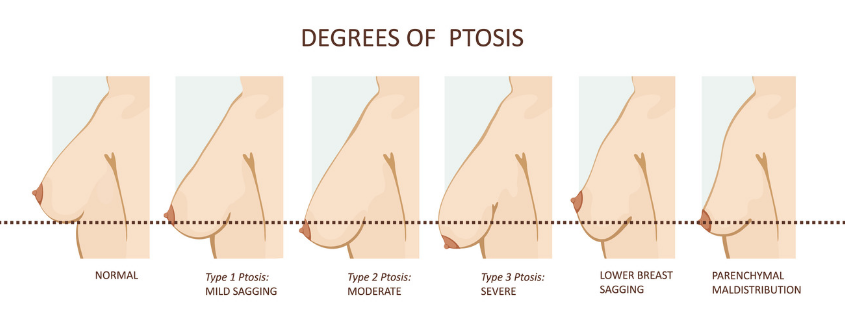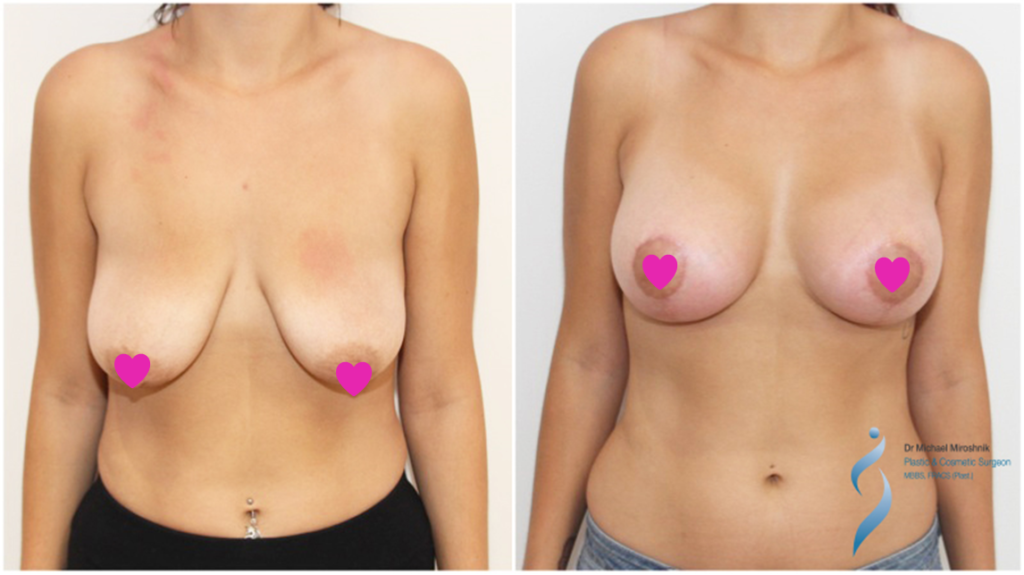
Breast ptosis is where a woman’s breasts are droopy, sagging and usually the nipples are pointing downward towards the ground. Breast ptosis – what is it and how is it treated? Well breast ptosis is a common reason why women seek out breast augmentation and/or breast lifts. Dr Michael Miroshnik, Specialist Plastic Surgeon based in Sydney NSW, discussed this subject at the recent Breast Masters Symposium at the end of 2018 and he chatted with and shared his presentation with us so we could better understand the condition and how plastic surgeons approach patients with breast ptosis.

Whilst breast ptosis can occur naturally as a part of ageing there are other factors that can contribute including:
- Ageing
- Pregnancy and breastfeeding (this is a big one, and breast ptosis can worsen with each pregnancy)
- Weight fluctuations
- Tuberous Shaped Breasts
- Naturally larger breasts (many women are genetically geared towards larger breasts which are more inclined to develop breast ptosis as they age – gravity!)
- Menopause
- Smoking – smoking causes a significant loss of skin elasticity. It is why smokers often look older than those who don’t, both in the face and body.
Collagen deficiencies and a loss of skin elasticity are the main reasons why breasts sag and the degree of ptosis is generally decided by the position of the nipple and glandular elements of the breast, and where they sit in relation to the breast fold, also known as the inframammary fold (IMF) – where the underside of the breasts connect to the chest.
Dr Miroshnik says there are different types of ptosis. “Ptosis presents in many different ways to our practice. Many techniques and approaches were developed in the 70’s when implants were in their infancy and we didn’t know much about glandular distribution, and we didn’t have sophisticated mastopexy (breast lift) techniques. I propose locally just a much simpler way of classifying things. So, dividing ptosis into nipple and glandular ptosis: nipple ptosis graded one, two and three; and glandular ptosis one, two and three, and it’s very easy to use. Type one, nipple above the IMF, type two nipple at the IMF, type three below the IMF; and the same with the gland, the bulk of the gland above the fold, the bulk of the gland at the fold or below the fold. You can also move into where the nipple is a three, the gland a one, and this is a tuberous style breast which must be approached as such.”

As Dr Miroshnik mentioned, different techniques and approaches should be used for each patient depending on the degree of ptosis and also what results the patient wants to end up with. “In the end the only difference is going to be whether they have an augmentation mastopexy or just a mastopexy alone, and you talk about the goals with the patient. I get many enquiries every day saying, doctor can I get away with an implant without a lift? This has got to be the most common email that a plastic surgeon receives”
What type or size of implants work to treat ptosis?
How long is a piece of string?! Of course it depends on the patient and their individual circumstances. However, Dr Miroshnik says there’s a fairly basic way of identifying how many cc’s work for a patient. “If you just remember 350cc for each 10cm of stretch and with every centimeter above and every centimeter below it’s another 100cc. Of course, you can see where this breaks down and it doesn’t work for all patients, but I’ve done this for thousands of patients and it works very, very well, and it just simplifies it all as a volumetric method. There are many other considerations such as the IMF which defines the lower pole of the breast and any breast surgery problems involve the inframammary fold in one way or another, but a good surgeon should be able to identify what is required to produce a pleasing result.”
If you’d like to learn more about Dr Michael Miroshnik check out his website, or if you’d like to make an appointment or consultation click here.
